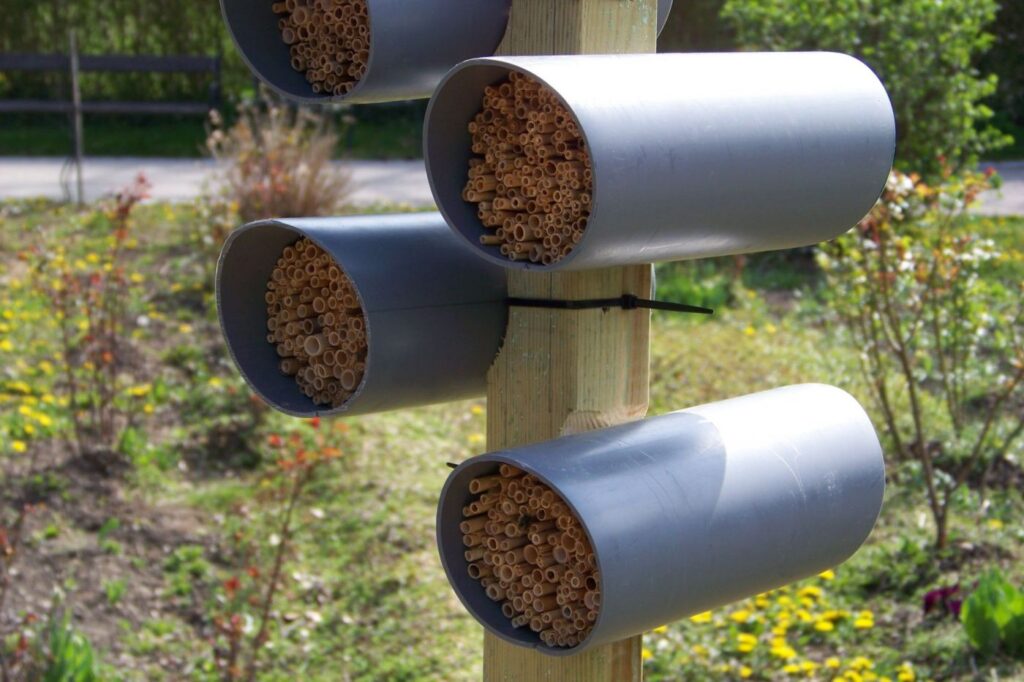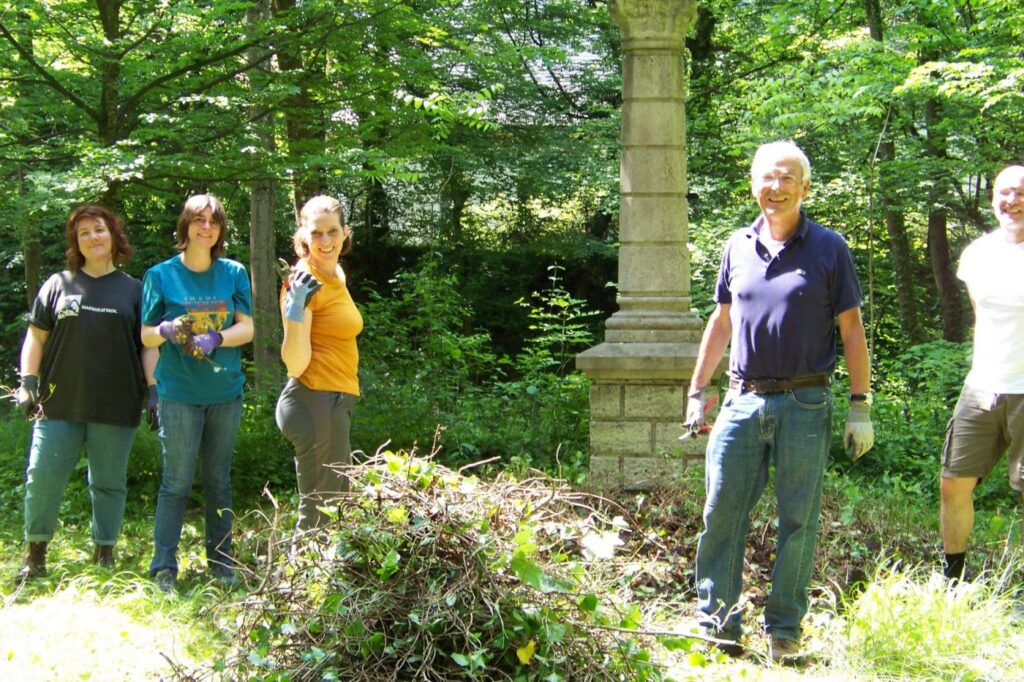How we love to hear the buzzing of bees and bumblebees, watch butterflies or rejoice when earwigs feast on aphids. But insects have become endangered species. Insect hotels are a good way to attract the little beneficial insects into our gardens – and then to enjoy them.
In the garden of our community in Neuburg an der Donau, Germany – within CJ’s Middel-European Province – there are some very special insect hotels in the middle of the various plants and trees.
They are small works of art and come from the hands of Sr Moderata Kögl CJ. Although she never studied art and did not attend an academy, she is nevertheless a talented artisan. For many years she gave handicraft lessons at school and to this day she enjoys being creative – preferably with watercolours and clay.
“Having clay in your hands is a wonderful feeling,” she reports. But it is not only the material and its handling that appeal to her. “Since I mainly want to depict biblical figures or current scenes, this work is also very meditative for me.”
Sr Moderata is often inspired by fellow sisters, friends and acquaintances. “I pick up an idea, a thought, and something emerges from it,” she explains her approach. It was the same with the insect hotels.

“A year ago, I formed a clay ball and put it in the flowers – the garden in our Neuburg house inspired me. After some time, insects lived in this sphere. Obviously, they felt at home there. That’s when I came up with the idea of insect hotels.”
Little by little, different “character heads” were created, each one individually designed, so that not only the insects, but also the viewers in the garden enjoy them. Sisters and visitors as well as guests of the retreat house are happy about the cheerful clay figures, which at the same time contribute to nature conservation. The special thing about it: The idea is easy to imitate for others who are interested, even if you do not have your own kiln, like the sisters in Neuburg. There is a pottery in the town that takes the artworks from Sr Moderata and puts them into its kiln.
Such a solution was also found in Bad Reichenhall, where Sr Moderata created an artistic nativity scene with biblical figures from the Old and New Testaments.
Sr. Moderata’s tip for all do-it-yourselfers who would like to try their hand at making their own individual clay figures for the garden: “The walls of the clay figures must be relatively thin, otherwise they will crack in the kiln.”
On these two initiatives you can read more here:
https://www.congregatiojesu.de/nachrichten/neues-leben-fuer-alte-stoffe
Where beavers and endangered plants thrive: Magdalenenpark in Pasing
“This area is something special, also for us from BUND Naturschutz. I’m happy every time I can be there.” When Martin Hänsel of BUND Naturschutz (BN) Kreisgruppe München – a German NGO specialised in safekeeping of the environment – talks about the park behind the CJ house in Munich-Pasing, he goes into raptures. After the Congregatio Jesu handed over the grounds around the Würminsel to BUND (the acronym stand for ‘League for Nature Conservation’), the nature conservationists are very active there, turning the garden and park into a nature conservation area, called “Magdalenenpark”.
“Our long-term goal is to preserve the beauty and ensure even more diversity,” says Mr Hänsel. The project is financed with funds from an inheritance. “This is also connected to making parts of the grounds accessible to the public – that is of course a balancing act, because the special uniqueness has come about precisely because the park was not accessible to the public.” Exactly what the concept might look like is still being planned, but a partial opening and BN-guided walks with information about nature and its treasures are conceivable. “We want to show what is possible if you make an effort and pay attention to nature – because amateur gardeners can also do that at home. That’s what we want to encourage.”
One way to do this is to create model gardens in the former vegetable garden. There, various beds are to be created that show how one can plant one’s own garden in a natural and diverse way. For example, it will also be shown how a classic lawn can be enhanced in the spirit of nature – step by step, visibly on different areas. In addition, plants will be shown that provide a home for bees, butterflies and other insects. But the garden should also continue to show that it was created as a monastery garden. “We want to preserve the character of the place and also keep its history visible,” explains the conservationist.
In the vegetable garden, mainly old vegetable varieties from organic seeds are to be cultivated. “It is important to us that we use autochthonous plants, i.e. plants that are native to the location,” explains the deputy managing director of the Munich district group of the BN. “Native plants are also genetically perfectly adapted to their environment and grow better. In addition, we contribute to biodiversity, i.e. the diversity of flora, and help to preserve it. Especially in times of climate change, where we will also need plants that can cope well with the changed conditions, this is an important task.”
Martin Hänsel is supported in his work by a team of volunteers. They are involved in all the work and have, for example, fertilised the garden with sheep wool and sheep manure and created a compost. They have also cleared the former Alpineum around the Lourdes Grotto. “It was completely overgrown, and now the grotto is much more visible again. One idea is to lay a path there showing various nesting possibilities for insects, so that you can observe them there without disturbing the animals,” Martin Hänsel reports.
The work sometimes also involves the removal of plants. “Ivy benefits greatly from the higher CO2 content in the air and can convert this into growth more than other plants. That’s why it has spread so much and is crowding out other plants. Therefore, we want to push it back to normal size and thus strengthen the flowering plants. Japanese knotweed has also spread far too much here. Since we deliberately don’t want to use pesticides and can’t graze the area with goats, we try to dig it out by hand and cut down the remaining plants regularly to weaken the invasive species so that it doesn’t displace more native plants.”
Among these native plants are also very special treasures. “We found the three-fingered saxifrage – an inconspicuous plant species, but one that is on the red list of plants threatened with extinction, which is incredible,” Martin Hänsel is pleased to say. The orchid species “white forest bird” has also settled on the site. “We found four sites, one at the foot of a lime tree and one at the edge of an ornamental hedge, which is something very special.”
The animal kingdom in the park also offers a great feature: “We have beavers on the site, which is a personal highlight,” the expert is pleased to say. “The beaver has been living on the Würm for about ten years and is a great asset.” However, there are also some things to consider when living together with the rodent. The nature conservationists have therefore provided trees that the beaver is not supposed to fell with protection and offer the animal so-called “diversionary feeding” to reduce the pressure on the tree population. When the beaver once again runs in front of the lens of the wildlife camera set up by the nature conservation NGO, everyone involved is pleased.
The sisters in Pasing are also happy about the new life for their old park. “The contact with each other is very good,” Martin Hänsel also confirms. “It’s always nice when the sisters meet us in the park and we can exchange ideas.” Sr Gonzaga Wennmacher CJ is a particularly active visitor – the many beautiful photos from the park also come from her. Many thanks!
By the way, more volunteers are welcome: If you would like to see the beaver in action or help to preserve the special flora of the Magdalenen Park, please contact the BN Munich District Group: https://bn-muenchen.de/bn-muenchen/geschaeftsstelle There, interested amateur gardeners can also get tips on how to design their gardens in a natural and diverse way.
© all photos: Sr. Monika Glockann CJ

News from www.congregatiojesu.de translated by Esther Finis
